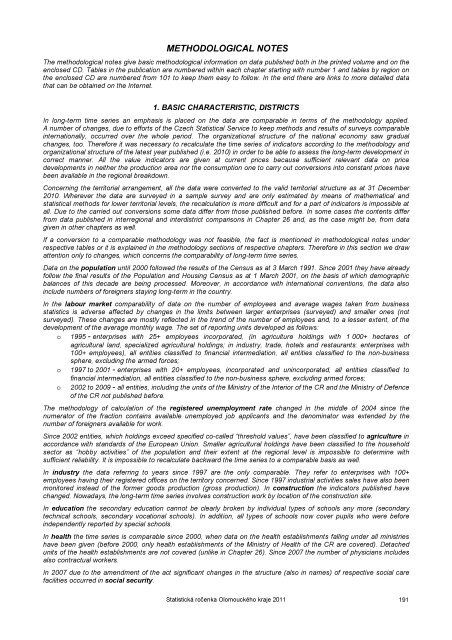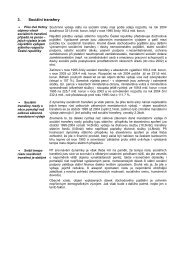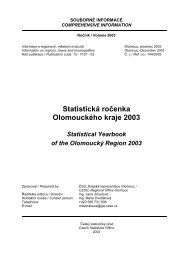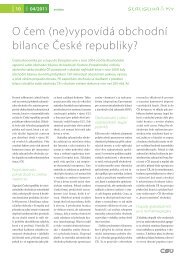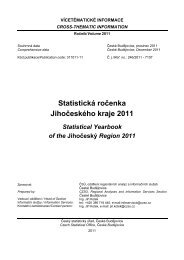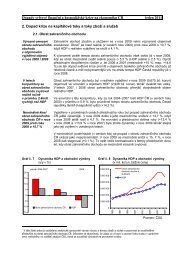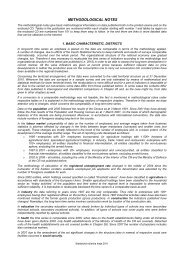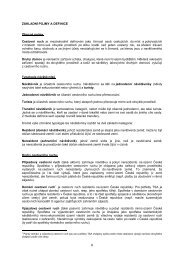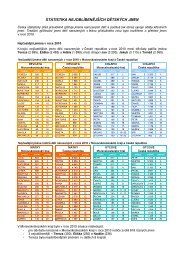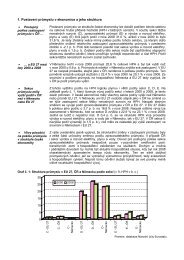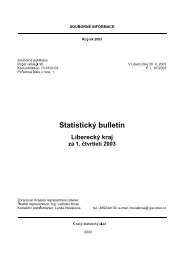Statistická ročenka Olomouckého kraje 2011 - Český statistický úřad
Statistická ročenka Olomouckého kraje 2011 - Český statistický úřad
Statistická ročenka Olomouckého kraje 2011 - Český statistický úřad
Create successful ePaper yourself
Turn your PDF publications into a flip-book with our unique Google optimized e-Paper software.
METHODOLOGICAL NOTES<br />
The methodological notes give basic methodological information on data published both in the printed volume and on the<br />
enclosed CD. Tables in the publication are numbered within each chapter starting with number 1 and tables by region on<br />
the enclosed CD are numbered from 101 to keep them easy to follow. In the end there are links to more detailed data<br />
that can be obtained on the Internet.<br />
1. BASIC CHARACTERISTIC, DISTRICTS<br />
In long-term time series an emphasis is placed on the data are comparable in terms of the methodology applied.<br />
A number of changes, due to efforts of the Czech Statistical Service to keep methods and results of surveys comparable<br />
internationally, occurred over the whole period. The organizational structure of the national economy saw gradual<br />
changes, too. Therefore it was necessary to recalculate the time series of indicators according to the methodology and<br />
organizational structure of the latest year published (i.e. 2010) in order to be able to assess the long-term development in<br />
correct manner. All the value indicators are given at current prices because sufficient relevant data on price<br />
developments in neither the production area nor the consumption one to carry out conversions into constant prices have<br />
been available in the regional breakdown.<br />
Concerning the territorial arrangement, all the data were converted to the valid territorial structure as at 31 December<br />
2010. Wherever the data are surveyed in a sample survey and are only estimated by means of mathematical and<br />
statistical methods for lower territorial levels, the recalculation is more difficult and for a part of indicators is impossible at<br />
all. Due to the carried out conversions some data differ from those published before. In some cases the contents differ<br />
from data published in interregional and interdistrict comparisons in Chapter 26 and, as the case might be, from data<br />
given in other chapters as well.<br />
If a conversion to a comparable methodology was not feasible, the fact is mentioned in methodological notes under<br />
respective tables or it is explained in the methodology sections of respective chapters. Therefore in this section we draw<br />
attention only to changes, which concerns the comparability of long-term time series.<br />
Data on the population until 2000 followed the results of the Census as at 3 March 1991. Since 2001 they have already<br />
follow the final results of the Population and Housing Census as at 1 March 2001, on the basis of which demographic<br />
balances of this decade are being processed. Moreover, in accordance with international conventions, the data also<br />
include numbers of foreigners staying long-term in the country.<br />
In the labour market comparability of data on the number of employees and average wages taken from business<br />
statistics is adverse affected by changes in the limits between larger enterprises (surveyed) and smaller ones (not<br />
surveyed). These changes are mostly reflected in the trend of the number of employees and, to a lesser extent, of the<br />
development of the average monthly wage. The set of reporting units developed as follows:<br />
o 1995 - enterprises with 25+ employees incorporated, (in agriculture holdings with 1 000+ hectares of<br />
agricultural land, specialized agricultural holdings; in industry, trade, hotels and restaurants: enterprises with<br />
100+ employees), all entities classified to financial intermediation, all entities classified to the non-business<br />
sphere, excluding the armed forces;<br />
o 1997 to 2001 - enterprises with 20+ employees, incorporated and unincorporated, all entities classified to<br />
financial intermediation, all entities classified to the non-business sphere, excluding armed forces;<br />
o 2002 to 2009 - all entities, including the units of the Ministry of the Interior of the CR and the Ministry of Defence<br />
of the CR not published before.<br />
The methodology of calculation of the registered unemployment rate changed in the middle of 2004 since the<br />
numerator of the fraction contains available unemployed job applicants and the denominator was extended by the<br />
number of foreigners available for work.<br />
Since 2002 entities, which holdings exceed specified co-called “threshold values”, have been classified to agriculture in<br />
accordance with standards of the European Union. Smaller agricultural holdings have been classified to the household<br />
sector as “hobby activities” of the population and their extent at the regional level is impossible to determine with<br />
sufficient reliability. It is impossible to recalculate backward the time series to a comparable basis as well.<br />
In industry the data referring to years since 1997 are the only comparable. They refer to enterprises with 100+<br />
employees having their registered offices on the territory concerned. Since 1997 industrial activities sales have also been<br />
monitored instead of the former goods production (gross production). In construction the indicators published have<br />
changed. Nowadays, the long-term time series involves construction work by location of the construction site.<br />
In education the secondary education cannot be clearly broken by individual types of schools any more (secondary<br />
technical schools, secondary vocational schools). In addition, all types of schools now cover pupils who were before<br />
independently reported by special schools.<br />
In health the time series is comparable since 2000, when data on the health establishments falling under all ministries<br />
have been given (before 2000, only health establishments of the Ministry of Health of the CR are covered). Detached<br />
units of the health establishments are not covered (unlike in Chapter 26). Since 2007 the number of physicians includes<br />
also contractual workers.<br />
In 2007 due to the amendment of the act significant changes in the structure (also in names) of respective social care<br />
facilities occurred in social security.<br />
<strong>Statistická</strong> <strong>ročenka</strong> <strong>Olomouckého</strong> <strong>kraje</strong> <strong>2011</strong> 191


